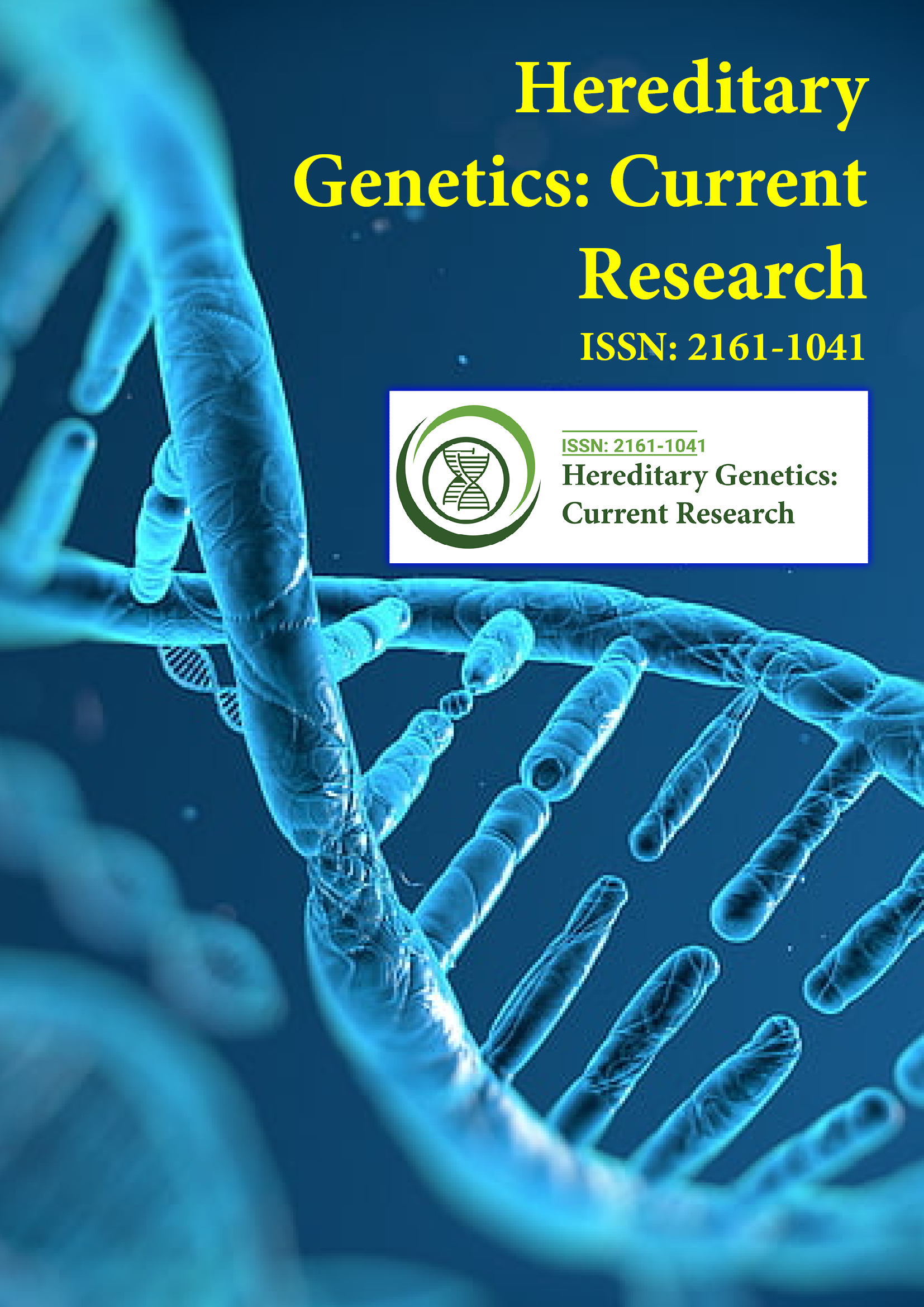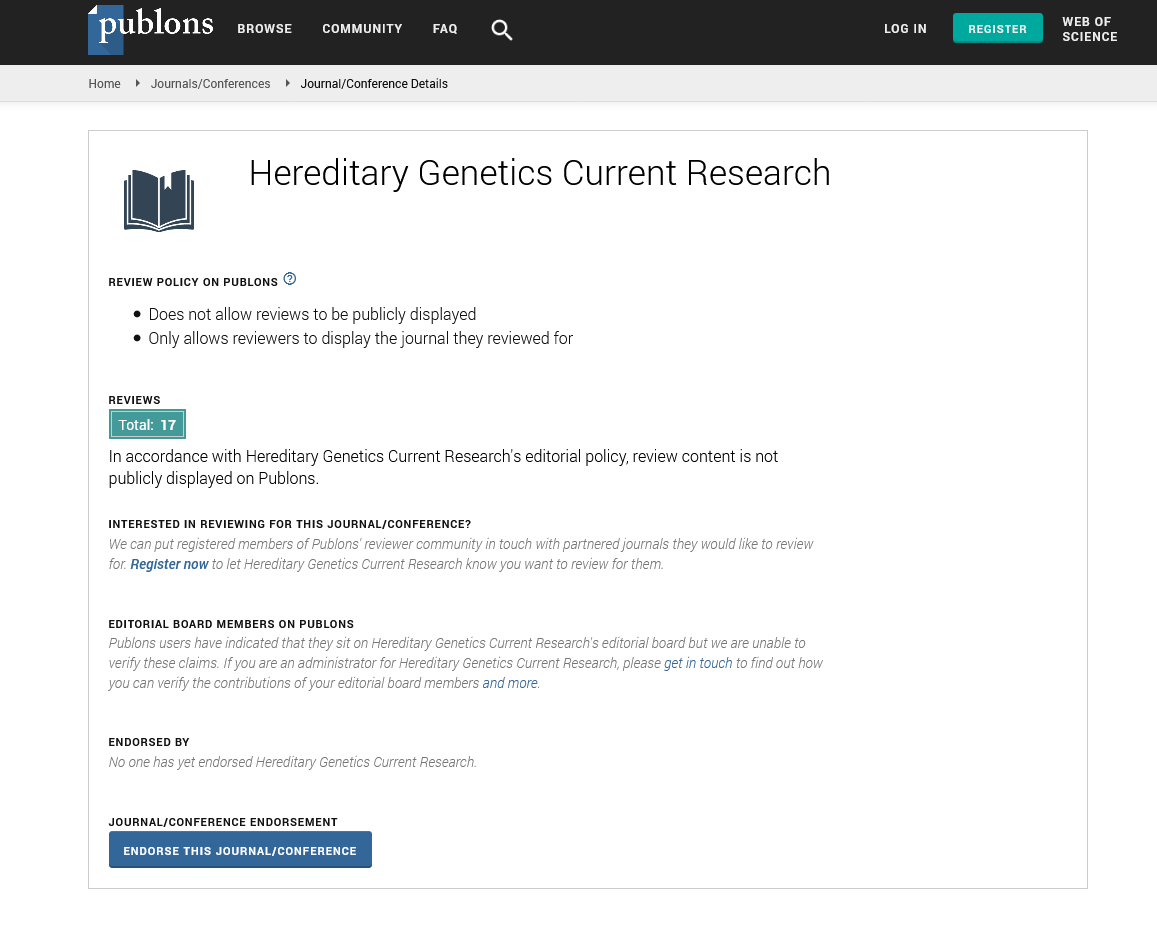Indexed In
- Open J Gate
- Genamics JournalSeek
- CiteFactor
- RefSeek
- Hamdard University
- EBSCO A-Z
- NSD - Norwegian Centre for Research Data
- OCLC- WorldCat
- Publons
- Geneva Foundation for Medical Education and Research
- Euro Pub
- Google Scholar
Useful Links
Share This Page
Journal Flyer

Open Access Journals
- Agri and Aquaculture
- Biochemistry
- Bioinformatics & Systems Biology
- Business & Management
- Chemistry
- Clinical Sciences
- Engineering
- Food & Nutrition
- General Science
- Genetics & Molecular Biology
- Immunology & Microbiology
- Medical Sciences
- Neuroscience & Psychology
- Nursing & Health Care
- Pharmaceutical Sciences
Opinion Article - (2024) Volume 13, Issue 1
Exploring Gene-Editing Techniques for Mitochondrial Hereditary Diseases
Wang Zhao*Received: 27-Feb-2024, Manuscript No. HGCR-24-26565; Editor assigned: 01-Mar-2024, Pre QC No. HGCR-24-26565 (PQ); Reviewed: 15-Mar-2024, QC No. HGCR-24-26565; Revised: 22-Mar-2024, Manuscript No. HGCR-24-26565 (R); Published: 29-Mar-2024, DOI: 10.35248/2161-1041.24.13.279
Description
Mitochondria the powerhouse of the cell are critical organelles responsible for energy production through oxidative phosphorylation. They possess their own genetic material, distinct from nuclear DNA and mutations in Mitochondrial DNA (mtDNA) can lead to a range of mitochondrial hereditary diseases. These diseases often result in severe and multisystemic disorders due to the essential role of mitochondria in cellular metabolism. Traditional therapeutic approaches for mitochondrial diseases have been largely symptomatic, focusing on managing symptoms rather than addressing the underlying genetic defects. However, recent advancements in gene-editing technologies offer promising strategies to directly target and correct mitochondrial DNA mutations.
The advent of gene-editing technologies, particularly CRISPR-Cas9, has revolutionized the field of genetic research and therapy. CRISPR-Cas9, a bacterial immune system-derived tool, enables precise and targeted modifications of the genome. However, its application to mitochondrial DNA has been challenging due to the unique properties of mitochondria and the lack of efficient delivery mechanisms for gene-editing components into these organelles. Recent breakthroughs have addressed some of these challenges. One notable approach is the development of mitochondria-targeted CRISPR systems. Researchers have engineered mitochondria-specific guide RNAs (mtgRNAs) and Cas9 proteins fused with Mitochondrial Targeting Sequences (MTS) to direct the CRISPR machinery specifically to the mitochondrial genome. This targeted delivery system enhances the specificity and efficiency of mitochondrial gene editing. In addition to CRISPR-Cas9, other gene-editing tools have been adapted for mitochondrial applications. Transcription Activator like Effector Nucleases (TALENs) and Zinc Finger Nucleases (ZFNs) are custom-designed enzymes that can identify and cleave precise DNA sequences. By fusing these nucleases with MTS, researchers have created MitoTALENs and mitochondria-targeted ZFNs, enabling precise editing of mtDNA. MitoTALENs and mitochondria-targeted ZFNs have shown potential in preclinical studies. These tools can selectively eliminate mutant mtDNA molecules, promoting the replication of healthy mtDNA and restoring normal mitochondrial function. For instance, MitoTALENs have been used to successfully reduce the heteroplasmy levels (the presence of both mutant and wild-type mtDNA) in cells derived from patients with mitochondrial diseases, demonstrating their potential therapeutic efficacy.
Another exciting development in the field of gene editing is base editing and prime editing. Base editors can convert one nucleotide into another without inducing double-strand breaks, offering a more precise and potentially safer approach for correcting point mutations. Prime editors, on the other hand, can perform targeted insertions, deletions, and base conversions by utilizing a reverse transcriptase and a guide RNA. Researchers have adapted base and prime editing technologies for mitochondrial applications. Despite these promising advancements, several challenges remain in the development and clinical translation of mitochondrial gene-editing therapies. Current delivery methods rely on viral vectors, nanoparticles, or direct injection, each with its own limitations in terms of efficiency, specificity, and safety. Additionally, the heteroplasmic nature of mitochondrial genomes poses a significant challenge. Mitochondrial diseases often result from a mixture of mutant and wild-type mtDNA, and achieving a sufficient shift in the heteroplasmy ratio to restore normal function is critical. Geneediting strategies need to be highly efficient and specific to selectively target and eliminate mutant mtDNA while sparing the wild-type mtDNA. Safety and off-target effects are also important considerations. Although mitochondrial gene-editing tools have shown high specificity in preclinical studies, the longterm effects and potential off-target mutations need to be thoroughly evaluated before clinical application. Rigorous testing in animal models and clinical trials will be essential to ensure the safety and efficacy of these therapies.
By directly targeting and correcting the underlying genetic defects, these therapies offer the possibility of long-lasting and potentially curative treatments. Patients with mitochondrial diseases could experience significant improvements in their quality of life, reducing the burden of symptoms and delaying or preventing disease progression. Furthermore, the knowledge and tools gained from mitochondrial gene-editing research could have broader implications for other genetic diseases and disorders. The techniques and strategies developed for mitochondrial applications can be adapted and applied to nuclear DNA, expanding the potential impact of gene-editing therapies across a wide range of genetic conditions. The development of mitochondrial gene-editing strategies represents a significant advancement in the field of genetic research and therapy. While challenges remain, the progress made in targeting and editing mitochondrial DNA hold the potential for the treatment of mitochondrial hereditary diseases. Continued research and innovation in this area will be essential to overcome current limitations and translate these innovative technologies in to clinical practice, an encourage to patients affected by these debilitating conditions.
Citation: Zhao W (2024) Exploring Gene-Editing Techniques for Mitochondrial Hereditary Diseases. Hereditary Genet. 13:279.
Copyright: © 2024 Zhao W. This is an open access article distributed under the terms of the Creative Commons Attribution License, which permits unrestricted use, distribution, and reproduction in any medium, provided the original author and source are credited.

